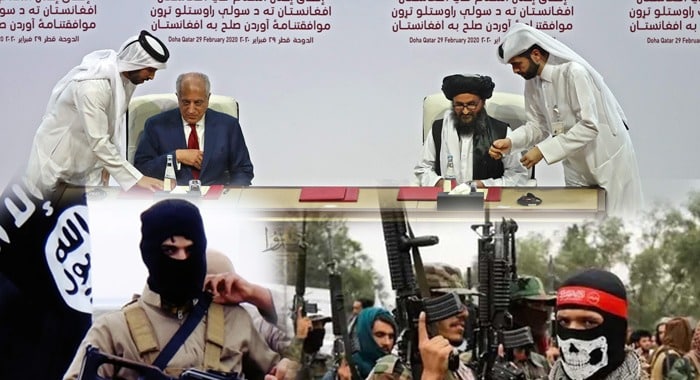Five years after the landmark 2020 Doha Agreement, Afghanistan remains a critical epicentre for terrorist activity, posing ongoing challenges to regional stability and global counter-terrorism efforts. Despite the Taliban’s public claims of compliance with the Doha deal, reports from the U.S. Office of the Director of National Intelligence (ODNI), the United Nations, and independent terrorism monitors paint a starkly different picture.
According to a latest report, terrorist groups such as Islamic State Khorasan Province (ISIS-K) and Tehreek-e-Taliban Pakistan (TTP) continue to exploit Afghanistan’s fragile security environment and socio-economic hardships to expand their reach and operational capacity. The Taliban, though now in control of Afghanistan, have been unable or unwilling to fully dismantle terrorist safe havens on Afghan soil.
ISIS-Khorasan: Afghanistan’s Most Dangerous Threat
ISIS-K remains the most capable and aggressive ISIS affiliate, responsible for numerous deadly attacks targeting the Taliban regime, ethnic minorities, foreign nationals, and diplomatic missions. The group claimed 22 attacks in the recent quarter alone, including high-profile suicide bombings in Kunduz and Kabul. UN sanctions monitors report ISIS-K’s resilience, noting its continued recruitment efforts from Central Asia and al-Qaeda affiliates within Afghanistan.
Moreover, ISIS-K operates a sophisticated financial network through its al-Siddique Office, leveraging cryptocurrencies to fund operations across Asia and the Caucasus. The U.S. Department of Justice’s recent arrest of Muhammad “Jafar” Sharifullah, an ISIS-K planner involved in the 2021 Abbey Gate attack that killed 13 U.S. soldiers and 170 Afghans, underscores ongoing threats emanating from the group.
The Pakistan-Afghan Taliban Nexus and TTP’s Growing Menace
The TTP, also known as the Pakistani Taliban, has flourished under Taliban governance, with an estimated 6,000-6,500 fighters mainly based in eastern Afghanistan. Supported financially and logistically by the Afghan Taliban regime, the TTP has intensified attacks inside Pakistan, aiming to control parts of northwestern Pakistan. According to the 2025 Global Terrorism Index, TTP’s deadly attacks surged fivefold since 2021, making it the third deadliest terrorist group worldwide.
Increased collaboration between the TTP, Afghan Taliban, and al Qaeda in the Indian Subcontinent has been observed, with joint operations under the umbrella of “Tehreek-e Jihad Pakistan.” New TTP training camps and recruitment efforts have been established in Afghan border provinces, indicating a dangerous expansion of influence that threatens Pakistan’s internal security and complicates bilateral relations between Islamabad and Kabul.
Al Qaeda’s Continued Footprint and Taliban’s Complicity
Despite international pressure, the Taliban continue to provide a permissive environment for al Qaeda, which is actively reorganising under leader Sayf al-Adl. Al Qaeda maintains ties with regional affiliates including TTP, the Islamic Movement of Uzbekistan, and the Turkistan Islamic Party, aiming to revitalise sleeper cells across multiple countries.
UN reports have revealed that the Taliban facilitate al Qaeda operations by issuing Afghan passports and national IDs to members, enabling their infiltration into neighbouring countries. Although U.S. assessments indicated al Qaeda was at an operational low in 2024, the group’s resurgence remains a serious concern for global counter-terrorism.
Regional and Global Implications
The presence of multiple terrorist groups entrenched within Afghanistan poses a complex threat to South Asia and beyond. Poverty, lack of education, and restrictive Taliban policies contribute to increasing radicalization, as highlighted by the UN Special Rapporteur for Afghanistan, Richard Bennett. The fragile security situation undermines international efforts to stabilize the region and combat terrorism.
Furthermore, foreign terrorist fighters continue to travel to Afghanistan, adding to the network of terror groups operating there. While anti-Taliban armed opposition groups remain active, they have not yet significantly challenged the Taliban’s control.
The Challenge Ahead
With approximately 200,000 Taliban security personnel reported and ongoing recruitment efforts, the Taliban claim they are strengthening their control. However, independent verification is lacking, and their ability to counter terrorist infiltration remains doubtful.
The international community, especially the United States and regional actors like Pakistan, faces an uphill battle to address Afghanistan’s evolving terrorist landscape. The resilience of ISIS-K, the resurgence of al Qaeda, and the expanding footprint of the TTP under Taliban patronage illustrate that Afghanistan remains far from a peaceful or stable state.
Efforts to counter terrorism in Afghanistan require renewed multilateral cooperation, intelligence sharing, and robust strategies that address both militant groups and the socio-economic conditions enabling their growth.





